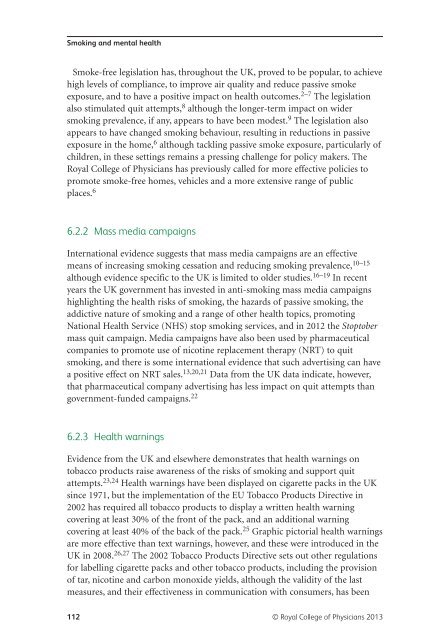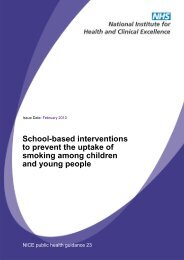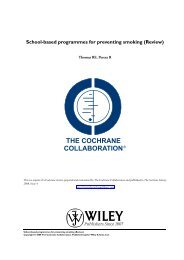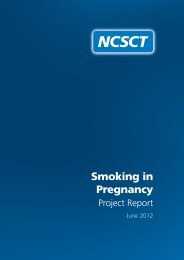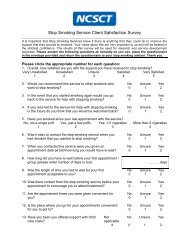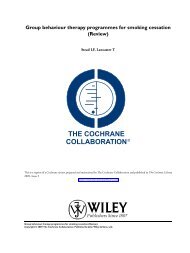Smoking and mental health - NCSCT
Smoking and mental health - NCSCT
Smoking and mental health - NCSCT
Create successful ePaper yourself
Turn your PDF publications into a flip-book with our unique Google optimized e-Paper software.
<strong>Smoking</strong> <strong>and</strong> <strong>mental</strong> <strong>health</strong><br />
Smoke-free legislation has, throughout the UK, proved to be popular, to achieve<br />
high levels of compliance, to improve air quality <strong>and</strong> reduce passive smoke<br />
exposure, <strong>and</strong> to have a positive impact on <strong>health</strong> outcomes. 2–7 The legislation<br />
also stimulated quit attempts, 8 although the longer-term impact on wider<br />
smoking prevalence, if any, appears to have been modest. 9 The legislation also<br />
appears to have changed smoking behaviour, resulting in reductions in passive<br />
exposure in the home, 6 although tackling passive smoke exposure, particularly of<br />
children, in these settings remains a pressing challenge for policy makers. The<br />
Royal College of Physicians has previously called for more effective policies to<br />
promote smoke-free homes, vehicles <strong>and</strong> a more extensive range of public<br />
places. 6<br />
6.2.2 Mass media campaigns<br />
International evidence suggests that mass media campaigns are an effective<br />
means of increasing smoking cessation <strong>and</strong> reducing smoking prevalence, 10–15<br />
although evidence specific to the UK is limited to older studies. 16–19 In recent<br />
years the UK government has invested in anti-smoking mass media campaigns<br />
highlighting the <strong>health</strong> risks of smoking, the hazards of passive smoking, the<br />
addictive nature of smoking <strong>and</strong> a range of other <strong>health</strong> topics, promoting<br />
National Health Service (NHS) stop smoking services, <strong>and</strong> in 2012 the Stoptober<br />
mass quit campaign. Media campaigns have also been used by pharmaceutical<br />
companies to promote use of nicotine replacement therapy (NRT) to quit<br />
smoking, <strong>and</strong> there is some international evidence that such advertising can have<br />
a positive effect on NRT sales. 13,20,21 Data from the UK data indicate, however,<br />
that pharmaceutical company advertising has less impact on quit attempts than<br />
government-funded campaigns. 22<br />
6.2.3 Health warnings<br />
Evidence from the UK <strong>and</strong> elsewhere demonstrates that <strong>health</strong> warnings on<br />
tobacco products raise awareness of the risks of smoking <strong>and</strong> support quit<br />
attempts. 23,24 Health warnings have been displayed on cigarette packs in the UK<br />
since 1971, but the implementation of the EU Tobacco Products Directive in<br />
2002 has required all tobacco products to display a written <strong>health</strong> warning<br />
covering at least 30% of the front of the pack, <strong>and</strong> an additional warning<br />
covering at least 40% of the back of the pack. 25 Graphic pictorial <strong>health</strong> warnings<br />
are more effective than text warnings, however, <strong>and</strong> these were introduced in the<br />
UK in 2008. 26,27 The 2002 Tobacco Products Directive sets out other regulations<br />
for labelling cigarette packs <strong>and</strong> other tobacco products, including the provision<br />
of tar, nicotine <strong>and</strong> carbon monoxide yields, although the validity of the last<br />
measures, <strong>and</strong> their effectiveness in communication with consumers, has been<br />
112 © Royal College of Physicians 2013


